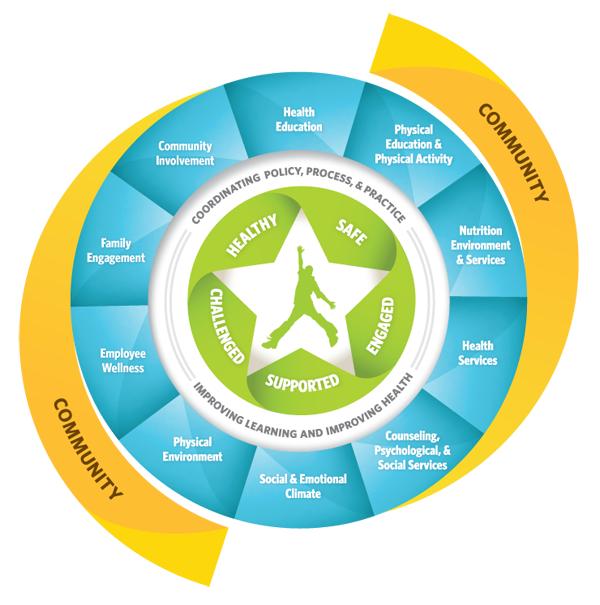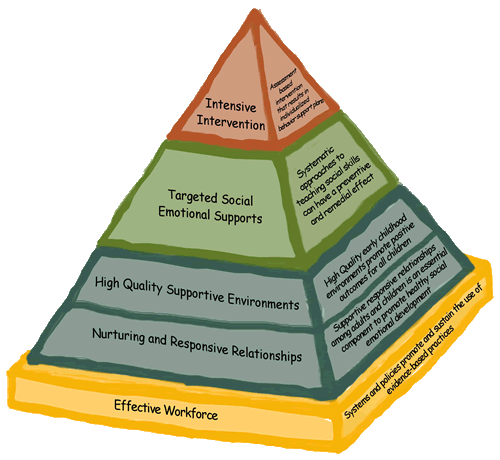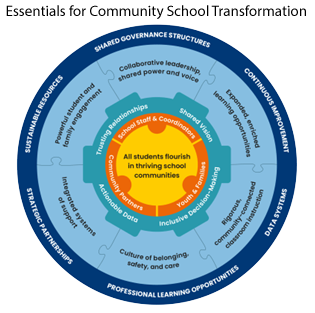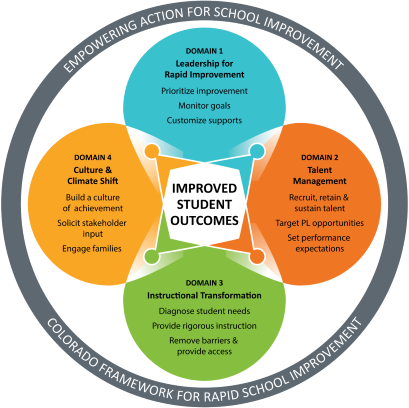You are here
Alignment with Other Frameworks
The Landscape of Alignment
There is no shortage of frameworks in education, with each seeking to make sense of complex systems in order to provide guidance and drive outcomes. The Landscape of Wellbeing and Belonging serves as a foundational and interconnected way of addressing all efforts seeking to make improvements in school health, safety, and engagement. Below are various national and Colorado-specific frameworks implemented in schools with explanations of how those frameworks align with the Five Features of the Landscape of Wellbeing and Belonging.
Interconnected Frameworks, Models, and Standards
The CASEL model is most closely associated with the Social Emotional and Behavioral Competency feature of the Landscape as the CASEL 5 provides descriptions of the teachable social and emotional skills that are foundational for overall health and wellbeing. A more thorough assessment of the CASEL model makes clear that other Landscape components are critical as well. Specifically, CASEL emphasizes the importance of establishing equitable learning environments and supportive classrooms and climates (i.e., the Landscape's Environment feature). Trusting and collaborative Relationships are also mentioned as being important as is the need to foster youth voice and engagement as well as community and family engagement. Engaging Learning Practices, in this instance refers to explicitly teaching and modeling social and emotional and behavioral competencies to students as learning is social and emotional. Finally, Health and Wellbeing is also foundational as the point of obtaining these skills is so that young people develop healthy identities, manage emotions, achieve personal and collective goals, feel and show empathy for others, maintain relationships, and make good choices.
Whole School, Whole Community, Whole Child (WSCC)
The Whole School, Whole Community, Whole Child (WSCC) model exists at the intersection of public health and education and seeks to improve a child's cognitive, physical, and social and emotional development by focusing on the whole child. The 5 features of the Landscape of Wellbeing and Belonging complement the integrated and collaborative approach espoused by the WSCC Model. Each of the 10 WSCC components can be found within the five features. The coordination of policy, process, and practice as described in the WSCC are key to implementation of the features. The outcomes of the Landscape are to have healthy, safe, challenged, supported, and engaged students, which aligns with the WSCC framework.
Positive Behavioral Interventions & Supports (PBIS)
The fundamental purpose of Positive Behavioral Interventions and Supports is to transform the learning environment and social culture to make schools more effective, efficient, and equitable. PBIS is both a framework and a set of practices to enhance social, emotional, and behavioral competencies. PBIS complements the Landscape work to increase wellbeing and belonging for the school community at large by focusing on the environment and elevating the function of relationships and building social, emotional, and behavioral competencies. PBIS also provides a framework to implement the integrated Landscape work.
The Essentials for Community School Transformation framework is aligned with all five Landscape of Wellbeing and Belonging features. Relationships are at the heart and center of the community school strategy and are featured at every level of the framework. This includes: individuals driving this collaborative and coordinated work; enabling conditions that need to be in place such as trusting relationships, shared vision, and inclusive decision-making; the key practices of collaborative leadership, shared power and voice; powerful student and family engagement; and the supportive infrastructure element of strategic partnerships. The Environment feature is aligned with the key practice of a culture of belonging, safety, and care. Health and Wellbeing and Social, Emotional, Behavioral Competencies are aligned with the key practice of integrated systems of support, which are often referred to as wrap-around supports. Finally, Engaging Learning practices are aligned with the key practices of rigorous, community-connected classroom instruction and expanded, enriched learning opportunities.
Family School Community Partnership Framework (FSCP)
The four essential elements of the Family-School Community Partnership P-12 Framework are aligned with all five features of Landscape of Wellbeing and Belonging. District, school, and community partners are encouraged to work in partnership with families to promote a school environment that is welcoming and inclusive of families, prioritize building trusting relationships with families, and dedicate necessary resources through community partnerships to promote health and wellbeing, among other outcomes. Additionally, families should be engaged in their child's learning through the school designing capacity building and leadership opportunities for families. Lastly, schools should co-create with families the social, emotional, and behavioral competencies they hope to build in students to ensure positive academic and life outcomes.
Colorado Dropout Prevention Framework enables schools to integrate foundational practices and strategies focused on academic achievement with measures of well-being, belonging, and connectedness including multiple pathways and establishment of early warning systems. Early warning systems provide the data regarding attendance, student behaviors, and course performance. The Landscape of Wellbeing provides guidance and resources regarding different foundational practices and the integration of essential pieces that are used to support the root cause of the issue.
Positive School Culture and Climate
School Culture and Climate is embedded in the Landscape of Wellbeing and Belonging in all of the 5 features. The Institutional domain of the Positive School Culture and Climate aligns with the Environment and Health and Wellbeing features in that the environment should provide safety and supports for wellbeing. The Interpersonal domain aligns with the Relationships feature as interpersonal relationships are foundational to success in school. And finally, the Instructional domain is represented in the Social, Emotional, Behavioral Competencies, and Engaging Learning Practice features as teaching of social and emotional skills and behavior is as essential as teaching students to read, and to do so students must feel engaged in what they are learning.
Unified Improvement Planning Process
The Unified Improvement Planning Process relies on data to inform improvement strategies at the school and district levels. Data that centers student, staff, and family wellbeing and belonging should be included as part of the review of data. Root causes for issues related to academics often center on areas for growth within each of the features of the Landscape of Wellbeing and Belonging: school environments, relationships, health and wellbeing, social, emotional, and behavioral competencies, and engaging learning practices. In order for schools to identify and implement major improvement strategies, root causes must be addressed or the problem will persist.
Four Domains for Rapid School Improvement
The 4 Domains for Rapid School Improvement can easily be found within the Five Features of the Landscape of Wellbeing and Belonging. A shift in climate and culture requires schools to examine their school environments, relationships, and social, emotional and behavioral competencies. Educator talent is enhanced by strong relationships, attention to health and wellbeing, and an increase in the development and modeling of the social, emotional, and behavioral competencies. Additionally, instructional transformation requires educators to support all students through engaging learning practices. All of this is incumbent on strong leadership for rapid improvement.
Special Education Formalized Support Plans
(Individual Education Programs, 504 Plans, Health Care Action Plans)
Special education plays a crucial role in fostering the Landscape of Wellbeing and Belonging by providing tailored support to students with disabilities and diverse learning needs. By addressing the unique challenges faced by students with disabilities, special education programs and other formalized support plans promote a sense of belonging and inclusion in the educational community. These formal plans not only enhance the overall wellbeing of students by empowering them to reach their full potential but also contribute to a more inclusive and compassionate society, where every individual's unique abilities and contributions are recognized and valued.













Connect With Us




